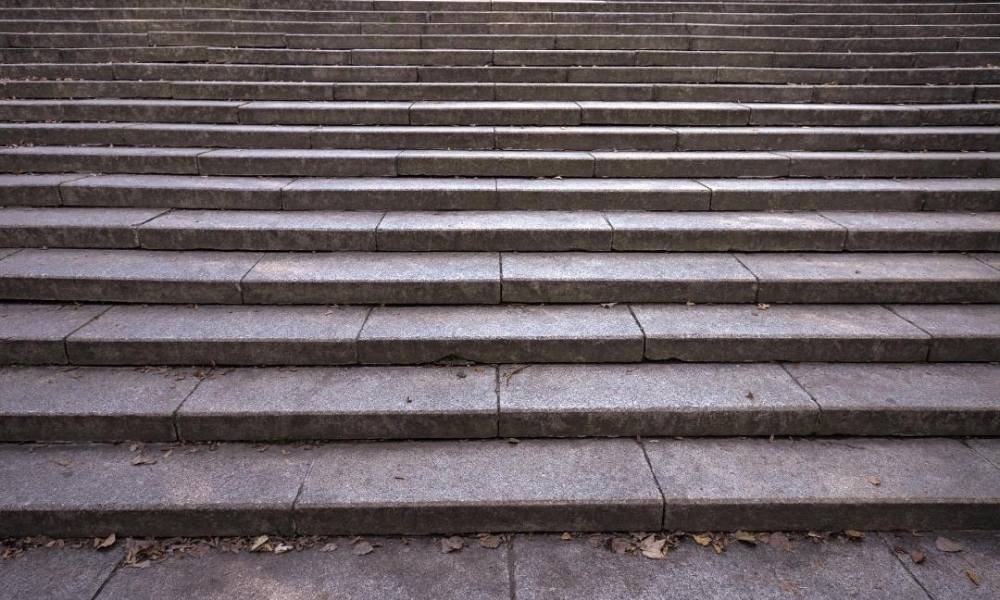Last updated on August 13th, 2024 at 09:24 pm
Think about glamorous entrances to buildings, and what do you see? Personally, I think of a set of steps leading up to it, welcoming us in. Often times, these are made of concrete. While we might think they are out of reach for us, they can be surprisingly affordable and beautiful option to spruce up our home exteriors.
If this sounds too good to be true, I understand your skepticism. So many articles talk a big game but provide no proof. Well, I’m here to help you learn what building them would cost for you by providing the building blocks of understanding! If you like what you hear so far, then stay tuned!

What is Concrete?
Now, I know what you’re thinking. Isn’t it obvious? I don’t need someone to explain what concrete is to me! Stay with me, there are several types of concrete for construction projects, so understanding the materials it is made out of will help give you an idea of the costs later on.
Concrete is an amalgamate of a chemically inert and hard substance called “aggregate” that is bonded with water and cement. So, concrete is not just cement on its own, as many of us may think. There is actually a strong history around it, and if you’re curious to learn more in depth.
That being said, it has come a long way since the time of the Ancient Egyptians who used lime and gypsum. Today, we use a binding agent called Portland cement – it was first developed back in 1824. Since then we have refined it a lot, but the core components remain the same. It is a combination of limestone and clay.

Aggregates
Now, concrete is usually defined by what aggregate is used. There are a few different types of aggregate: fine and coarse. I will try not to get too technical here, but this is something important to consider if you are planning on building anything out of concrete.
The fine type is usually small pieces of the mix, while the coarse is larger pieces of it. Most critically, whatever aggregate is used must be clean. It should not contain any foreign particles like vegetable matter because that could compromise the resulting concrete.
Mixtures of it, and the ratio of it to water and cement will determine the eventual “character” of the concrete, as it is called. Different amounts of the aggregate will be used depending on what strength is needed and the availability of the materials.

Why Concrete?
This is a somewhat complicated question to answer. After all, making home improvements is something deeply personal to us. Trying to decide what options we want to take, especially for the front entrance or back entrance to our house is something we really need to consider.
Maybe you’re wondering “why would I not just use wood?”
Well, I can offer a few reasons why you may not want to choose wood. First, you’ll want to think about what your actual house is made out of.
Aesthetics are not the only important thing, but they are certainly something to think about. If you have a brick exterior, cement steps will likely look a bit more cohesive. They suit the overall design of the outside of your home more than wood, often times.
Of course, you need to keep a few other things in mind as well. First, consider how wide you need the steps to be. Wooden steps require support beams, and if you go over forty eight inches, they will need three of them – which can be costly and frustrating to make. Concrete is usually preferred for a larger project.
The height of the stairs will also impact your decision. You will probably want to check out the building codes in your city before you start a project like this, as the numbers of steps will impact what material you should use and whether you need to install a railing as well.
The amount of people that will walk on the steps should also be a part of what you choose. If they will receive heavier foot traffic, you will likely want to build them with something that will last. Having someone hurt themselves because of a broken step would be terrible!
The final consideration I would like to bring to your attention is overall durability. You know the weather patterns in your neighborhood best. If there is a lot of rain, wind, or snow, wood is probably not the best choice for you. Durable materials will last longer and require less upkeep – no one wants a hassle, after all.
What are the Costs?
As with the points above, there are a lot of different factors here. Mostly, the material you choose to use will influence this. The most affordable option for building exterior steps is wood. However, like I mentioned, there are a lot of drawbacks to them.
Concrete steps are really not that much more expensive. Because there are pre-poured options that are in specific, pre-determined dimensions, there are plenty of affordable ways to install them. The type of aggregate used can also have an impact here.
Some other things that go into this are things such as whether you want to have hollow or solid concrete steps.
There are certain pros and cons to each option, and if you are considering hiring a contractor to install yours, you may want to discuss it with them. Otherwise, you will want to research what the best option for your home will be by plugging in other factors like foot traffic, height, and width.
The final parts of the process that I will discuss today are the costs of set up and clean up and the overall labor costs.
This will obviously have an effect on the overall costs. Hourly rates will probably vary depending on where you live. Compare all of your options as you decide on your method of installation and the type of steps that you ultimately choose!




